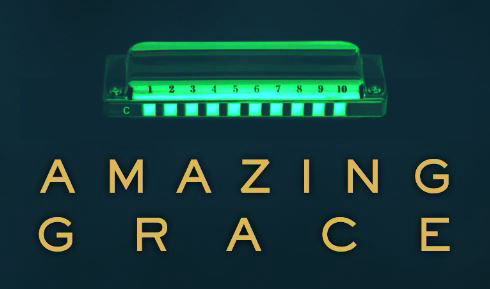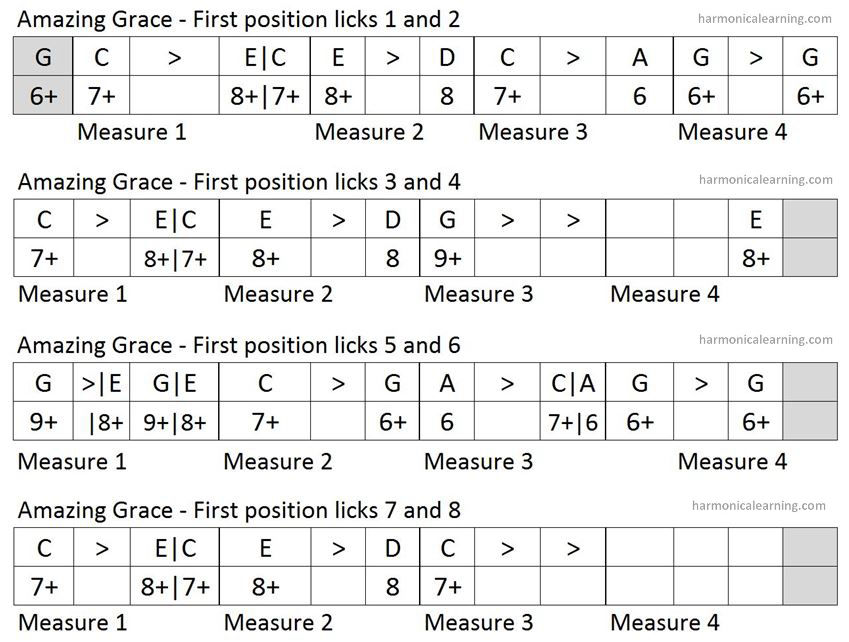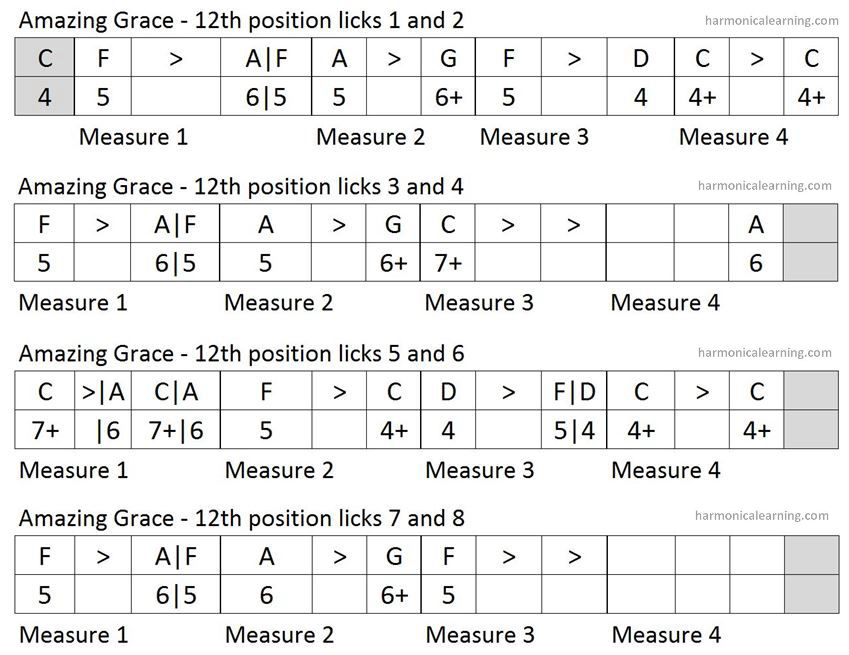
Amazing Grace on harmonica sounds really sweet, and that’s why I decided to create this lesson for beginner players. However, in teaching you how to play this song, I’ll also be providing some useful theoretical knowledge and show you how to perform the tune on the harmonica in different positions; you’ll learn to play it in first position, second position, and twelfth position. Why would you want to learn such a simple song in different ways? The answer is that in doing so, you really internalize the song and acquire new skills on the harmonica. Believe me, simple stuff often leads to big changes in your playing.
With this lesson, you’ll get the tabs, play-along video, and backing tracks, and to make your practice even easier, I’ve also provided the slow version of the videos. You’ll play Amazing Grace on a C harmonica if you plan to study with the videos, or you can opt for a different key (all of them are good) if you want to play alone. So, let’s start our journey and take a look at the song structure.
The track, one of the best-known known songs in Western music, is based 90% on only three chords: if we play in first position on a C harmonica, these chords are C major, F major, and G major. Why these three chords? Simply because they’re the most important chords of the tonality. Let me explain a very useful point about songs and music in general: the chords with which a song is built are defined by the harmonization of the song’s key scale. For example, if you work on a C major song, you can use the following chords: C major, D minor, E minor, F major, G major, A minor, and B diminished. If you want to learn more about this topic, try searching online for ‘major scale harmonization.’
Going back to Amazing Grace, these are the chords: C, C, F, C, C, C, G, C, C7, F, C, Am, G, C, G7. As you see, there’s also an A minor and C seventh, which are meant to make the harmony a little more interesting while not really changing the song.
What movement does the harmony have in this tune? It starts from the root chord C major and moves toward the fifth degree chord, G major. This repeats twice, and notice that after every G, we find the root chord C. This is typical of many songs, and if you can grasp this concept, you make another step forward in your harmonica playing skills.
Let’s now analyze the Amazing Grace melody, starting from first position, where the root note of the song is C. Here are the tabs:
6+ 7+, 8+ 7+ 8+, 8
7+, 6 6+, 6+
7+, 8+ 7+ 8+, 8
9+, 8+
9+, 8+ 9+ 8+ 7+, 6+
6, 7+ 6 6+, 6+
7+, 8+ 7+ 8+, 8
7+

In this first version, you’ll play on the top harmonica notes, holes 6 to 9. This is a great exercise for beginners, who often neglect to learn how to manage them. I suggest you treat every harmonica hole with the same ‘respect’.
Amazing Grace starts with an introductory note, G, that resolves on the root note C. Then, you’ll play the notes E, C, and E, which means playing the two most important notes of the song. In fact, C is the home note and E is the third-degree note that determines the song’s scale mode: major. From the point of view of the tonality, the first lick ends with the G note, the third most important one in the key of C. Did you know that C, E, and G form the C major chord? These notes are very safe to play in this context!
In the second lick, when the harmonica goes to the F chord, you’ll play the note A, the major third note of the F major chord, perfectly concordant with what we just learned! Do you know what the purpose is of the C seventh chord? It’s used to resolve on F major – the same thing that happens when the G chord resolves on the C chord.
What happens when you play the last lick on the A minor chord? The note C is the minor third note of the A chord; once again, you’ll play a very safe note in the context of the harmony.
Amazing Grace is a simple tune, but whenever you study something, you can go deeper and gain much much more than what you would if you tried practicing something too hard for you. Remember: simple concepts, good analysis, and knowledge of what you’re practicing and why: that’s my way of teaching. There’s plenty of other instructional material out there that seems all the same, and actually, it usually is.
Okay, now that you’ve practiced the song in first position, let’s see how to play it in a different way: the second position. What you should do is transpose the chords and the licks, I’ve already done this in the videos, so you’ll only need to follow the tabs and play everything with the same C harmonica.
Here are the tabs for Amazing Grace in second position:
4 6+, 7 6+ 7, 6+ 6+, 5+ 4, 4
6+, 7 6+ 7, 6 8, 7
8, 7 8 7 6+, 4 5+, 6+ 5+ 4, 4
6+, 7 6+ 7, 6 6+

The song key is now G major and you can see that you’ll play in the center harmonica area. The song is also easier and not too intense. However, if you want to play this version on the lower octave, you should perform a whole-step bend on hole 3 to get the note A. If you can already bend notes, give that a try! Here are the tabs:
1 3+, 3 3+ 3, 3’’ 3+, 2+ 1, 1
3+, 3 3+ 3, 3’’ 4, 3
4, 3 4 3 3+, 1 2+, 3+ 2+ 1, 1
3+, 3 3+ 3, 3’’ 3+
What’s the point of learning a song in several different ways? Well, if you’re playing with a band or on a backing track, and the key in which the band or backing track is playing is different from your harmonica key, you can play your instrument in a different position, and still stay perfectly in tune! Isn’t this a great advantage? Let’s take an example. You’ve found Amazing Grace with a backing track in G: you can play the song in first position with a G harmonica, in second position with a C harmonica, or in twelfth position with a D harmonica.
If we want to play the song in twelfth position, the key of the song would be F major; here are the new tabs:
4+ 5, 6 5 6, 6+ 5, 4 4+, 4+
5, 6 5 6, 6+ 7+, 6
7+, 6 7+ 6 5, 4+ 4, 5 4 4+, 4+
5, 6 5 6, 6+ 5

With this version, you’ll likewise play on the harmonica center. Do you want to try it in the lower version? You’ll need to bend more notes on holes 2 and 3! Here are the tabs:
1+ 2’’, 3’’ 2’’ 3’’, 3+ 2’’, 1 1+, 1+
2’’, 3’’ 2’’ 3’’, 3+ 4+, 3’’
4+, 3’’ 4+ 3’’ 2’’, 1+ 1, 2’’ 1 1+, 1+
2’’, 3’’ 2’’ 3’’, 3+ 2’’
I know what you’re thinking now: that’s a really hard job! Yes, and also a really great bending exercise for intermediate players! Go back to this lesson in one year if you’re a beginner now and see how you do.
The last thing I want to show you in this lesson is how to improvise something while playing Amazing Grace. You’ll play in second position – no bending is required, but you will need some skill to play some of the more articulated licks. Here are the tabs:
4 6+, 7 6 6+ 7, 6
6+ 5+ 6+ 6 6+ 5+ 4, 4
6+, 7 6 6+ 7 6 6+ 8, 7
8 7 8 8+ 8 7 6 6+
4 5+ 6+ 6 6+ 5+ 4, 4
6+ 6 6+, 5+, 7 6 7, 6
6+, 5+ 6+

This last Amazing Grace version for harmonica is not really for beginner players, but it shows how you can improve on taking simple things and elaborating them. In the case of this song, you’ll notice that I also changed the tempo feeling to something freer during the execution.
Now it’s time for you to practice! In the videos below, you’ll play the first position version twice, then the twelfth and second position version, and finally the enhanced improvisation. Enjoy!
I hope you enjoyed learning with me and I invite you to share this lesson with your friends. See you in a new lesson soon!
Share this page with your friends!